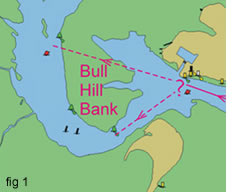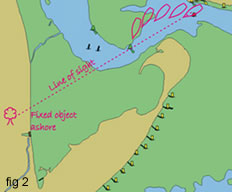
Buoy hopping
Buoy hopping is a very useful skill to employ in a narrow, well lit channel or estuary.
There are, however, a few basic pitfalls that you need to be aware of in order to avoid disaster.
Missing a buoy or two
The first of these is the straightforward risk of missing a buoy or two, and thereby cutting the corner. Figure 1 shows Exmouth entrance. Having arrived at the figure X in Fig 1, for instance, it would be very easy to see the red buoy about half a mile away and almost straight ahead, rather than head to port towards the green buoy.

The first line of defence against this trap is preparation: make a note, either on a notepad or on the chart itself, of the bearing and distance from each mark or turning point to the next.
Armed with that information, you should know exactly where to look for each buoy even before you arrive at the one before it. If the worst comes to the worst, you can always turn the boat onto the required bearing, and be confident that the mark you are looking for will be somewhere in front.
Losing track
A related problem is to lose track of which buoy you have reached, and to either not realise how far you've come or to skip a few, and believe yourself to be further on than you really are.
This is particularly true of long, winding channels, where there may be literally dozens of buoys or beacons.
The defence against this one is to keep a careful record of each mark as you pass it, either ticking it off on your pre-prepared list, or by ticking it off on the chart, or by marking each one up as a single point fix.
Wind and tide
The most subtle trap for buoy-hoppers is caused by wind and tide. Again, Exmouth provides a good example because once the tide has risen high enough to cover Bull Hill Bank, it flows strongly straight up the river (see fig 2).

In Fig 2, a boat has come in through the entrance, and has made the correct turn into the channel. The tide, however, pushes her strongly sideways, towards the shallows. The helmsman is still steering straight towards the buoy, but is now well off track.
With the tide still pushing them sideways, the actual ground track achieved by simply aiming at the buoy will be a curve, bulging down-tide of the intended track, and possibly coming to an abrupt halt on the bar.
Even if that doesn't happen, it can be very disorientating to arrive at a buoy from the wrong direction.
In fact, if the boat is approaching having been swept down tide, it will be almost directly abeam. The best way to stop either of these things from happening is to look beyond the target mark, to find some kind of landmark.
Impromptu transit
It need not be on the chart: it could be a boat on a mooring, a bush or parked car. It must, however, be stationary and likely to remain so for as long as you need it (a cow that is lying down would be OK, but one which is standing up would not!)
The landmark and the target together form an impromptu transit which you can't easily plot on a chart, but which nevertheless provides an easy way of following a dead straight track from where you are, to the buoy or beacon.
These are just a few basic tips, to learn more about navigation, pick up a copy of Tim Bartlett's RYA Navigation Handbook.
Contact UsArticle Published: March 17, 2011 15:11
Article Updated: August 19, 2013 16:01